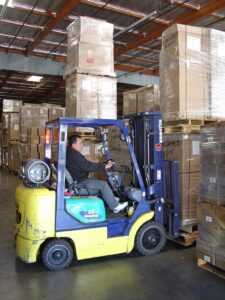How Efficient Product Slotting Can Dramatically Boost Warehouse Productivity
Warehouse managers know just how critical an optimized layout is to the overall efficiency of a warehouse operation. The layout of your building plays a huge role in how quickly your staff can pick product and stock shelves, thus impacting shipping and receiving functions. A key juncture in the supply chain, warehouse operators bear the responsibility for ensuring their companies are operating at maximum efficiency.
Product slotting is one way to work towards optimization. There are several methods warehouses may use to optimize slotting. Below, we outline several approaches to effective product slotting and strategies that can boost productivity. Use these ideas to jump start a planning session for restructuring your building’s layout for optimal efficiency.
Product Slotting Goals
Better product slotting aids warehouses in achieving several key objectives, including:
- Reductions in picking time
- Reductions in travel time
- Avoidance of aisle congestion
Through a careful analysis of a pick cycle, you can determine the portion of total picking time that is spent traveling through the facility. In some cases, travel time can make up between 40% and 65% of total picking time, which can often be substantially decreased with more effective product slotting.
One way to pinpoint areas for improvement is to identify slow and dead pallets that staffers are traveling past in order to reach their destinations. If your staff are passing several slow or dead pallets, you have a viable opportunity to achieve efficiency gains through a few simple product slotting changes.
Aisle Numbering Schemes
Laypersons may think that aisle numbering is an insignificant factor when it comes to warehouse efficiency, but simple numbering mechanisms can greatly impact staff productivity. The tendency for many is to number aisles consecutively, starting at number one, from one side of the building to the other. Despite its simplicity, this aisle numbering scheme often results in much wasted time if aisles are not re-mapped to the facility’s picking system.
Starting at the middle, with odd-numbered aisles on one side and even-numbered aisles on the other, is one method for improving efficiency. Configuring product placement so that fast-moving items are located in the lower-numbered aisles with slow-moving product in the higher-numbered aisles places the most frequently picked and stocked items in the prime middle area of the facility, reducing the time staffers spend passing non- and slow-movers to get to in-demand products.
Instead of cross-aisles or tunnels at the midpoint of each aisle, placing cross-aisles about one-third of the way down the aisle and stocking in-demand products in this third of the aisle further streamlines the picking process and cuts down on wasted travel time.
End-Aisle Promotional Bulk Placement
Promotional items are often the fastest-moving products during the promotional time frame. Placing these products in bulk on aisle ends makes these fast-moving items easily accessible while also minimizing added congestion within interior aisles. Additionally, this placement allows for easier relocating when it’s time to make room for new promotional product.
The same strategy can be used to optimize your layout by product seasonality. If your warehouse handles seasonal products, it’s worth reconfiguring your product to place in-season items in the prime areas you’ve designated to enable streamlined picking with minimal travel time and congestion. Move out-of-season items to the farthest, least-accessible locations in the off season, ensuring that staff won’t be wasting travel time passing by product not likely to be moved.
Place Affinity Products in Close Proximity
Another logical and relatively simple method to implement is to place affinity products – products almost always ordered in sets, pairs, or groups – within close proximity. Fortna points out that it makes little sense to store items generally purchased in pairs at opposite ends of the building. It’s an easy fix that can quickly eliminate a considerable amount of wasted travel time.
Group Products by Similarity (Pallets or Cases, Customer Base, or Other Shared Characteristics)
In addition to placing frequently grouped items in close proximity, many warehouses use other shared characteristics to determine product slotting. For instance, grouping products according to whether they’re moved in full or partial pallets or cases can streamline picking and loading, while grouping products by customer or special packaging or shipping requirements can also result in efficiency gains.
With a variety of approaches to more efficient product slotting, it’s not feasible to use every strategy within a single warehouse. It’s practically guaranteed that two or more strategies would result in conflicting ideal layouts, and too many rules simply create confusion. For that reason, strategic planning is advisable to run projections and simulations that can help you determine which slotting strategies will produce the largest gains for your operation.


全部 0条评论